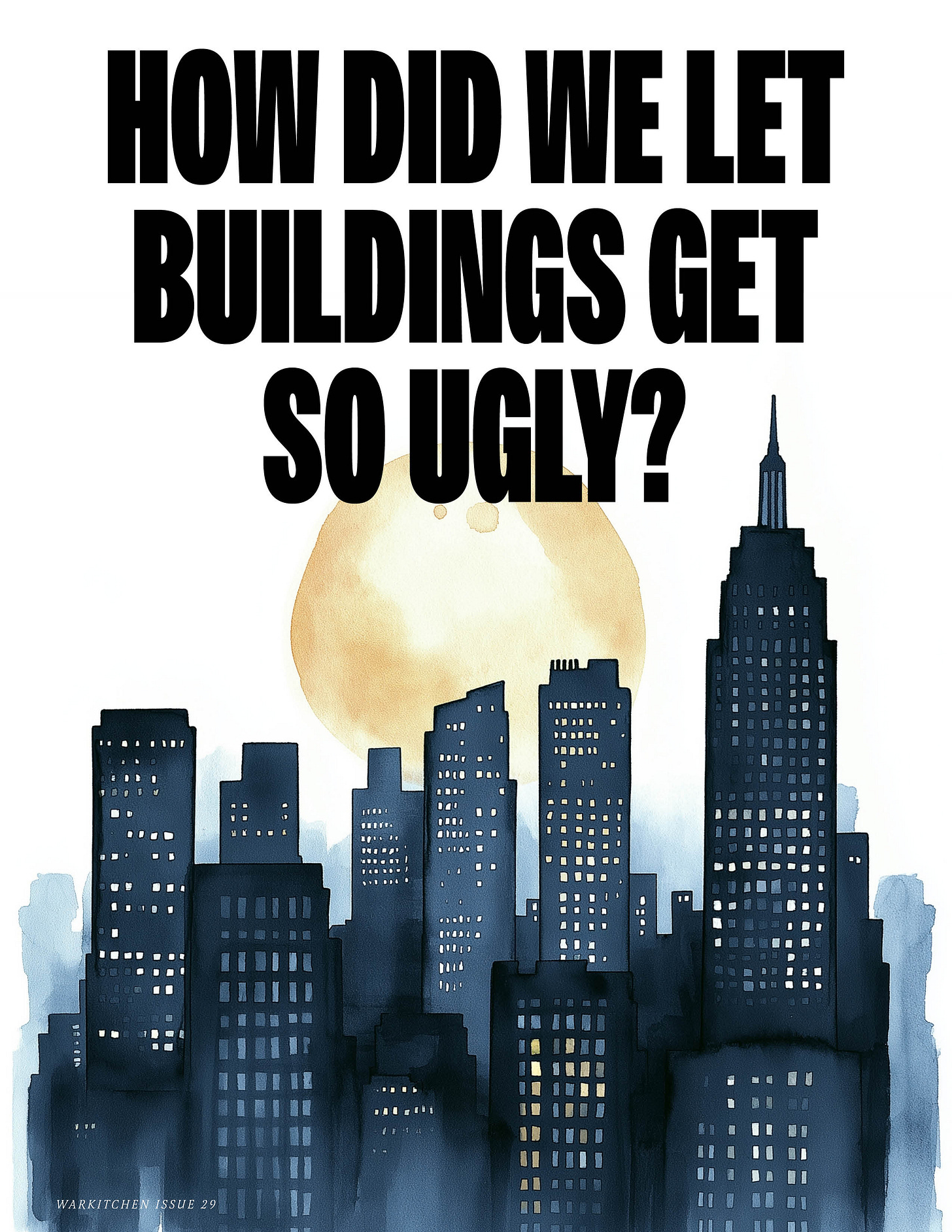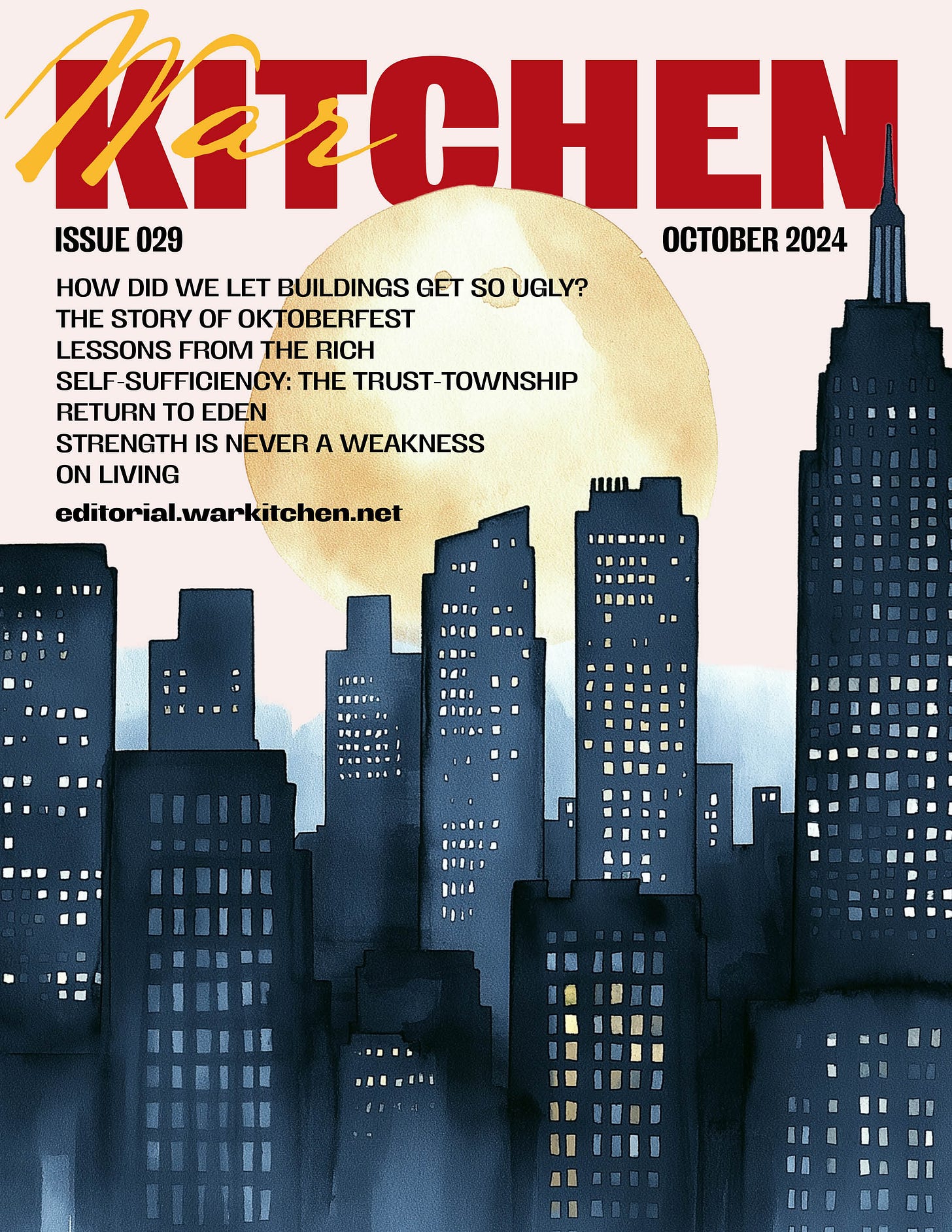How did we let buildings get so ugly?
We must bring beauty back
Have you ever taken a moment to truly observe the buildings that we, as humans, are constructing today? Look around at the urban landscapes and the residential developments spreading across cities and towns alike. The uniformity of design, the repetitive nature of these structures, and the assembly-line approach to creating homes stand in stark contrast to the individuality and charm that used to define dwellings in previous generations. These buildings, which are supposed to serve as peaceful sanctuaries and personal retreats, often feel soulless and detached from the very essence of what a home should be. They seem to be mass-produced in a way that prioritizes efficiency over creativity, functionality over aesthetics, and conformity over personal expression.
If we take a step back and compare today’s housing to that of the past, the evolution becomes even more apparent. Once, homes were crafted with care, using local materials, often reflecting the unique cultural and environmental context of the region. Each house told a story of the people who lived in it, their needs, desires, and aspirations. Today, however, many homes appear as mere products of a housing market designed to meet quotas rather than to provide individuals and families with spaces that truly nourish their sense of belonging and comfort.
Once, homes were crafted with care, using local materials, often reflecting the unique cultural and environmental context of the region.
It’s fascinating to think about how this shift happened, how the architecture of homes has changed so drastically over time. From the quaint cottages and grand townhouses of the past to the sprawling suburbs and high-rise apartments of the modern era, housing has always mirrored the socio-economic realities of its time. But at what cost? Are we sacrificing the very qualities that make a house a home in favor of efficiency and modernity? Let’s take a closer look and explore the evolution of houses and the cultural, technological, and economic factors that have shaped the way we live today.
History
Since the dawn of time, humans have been creating shelters to provide comfort and security for themselves. In the prehistoric era, people would shelter under trees to protect themselves from the sun, rain and the wind. Not long after, people would start living inside caves for the same purpose, some people even live in caves to this day! In these caves they made fire, put up drawings of everyday things, ate and reproduced. The first known houses as we know them today were built in 3100 BC by the Egyptians. The Egyptian elite would live in more luxurious homes whereas the peasants would live in more simple, but still practical homes.
These types of homes continued in various cultures for many centuries. But the one thing characterizing all these homes is that they were built for the entire family, including grandparents. After a long time, governments started building terraced houses to house more workers, like the famous Vicars’ Close, built in the 14th century. These types of houses were continued for years and years on end and they made a return in newly developed houses, as they are easier to reproduce meaning fewer costs for the construction companies which increases their turnover.
This disregard for aesthetic appeal has resulted in a landscape filled with monotonous structures that lack character and individuality. The once-vibrant and diverse architectural tapestry is being replaced by a bland and uniform urban fabric.
It was only at the start of the industrial revolution that people started living in so called single-family detached homes. This is the turning point where homes became their most beautiful for the everyday person. Where the elites always had palaces or massive houses to live in, these homes now allowed the working class to have a little palace of their own. Single-family detached homes are arguably the best houses we have ever built as humans.
Modern situation
The houses being constructed in this era are often mass-produced, lacking the distinctive architectural qualities of the past. It’s as though construction companies have abandoned their pursuit of beauty, focusing solely on maximizing profits by churning out as many dwellings as possible. This trend has led to a proliferation of cookie-cutter homes that often fail to inspire or captivate the imagination. The once-prized art of architecture seems to have been relegated to a secondary concern, overshadowed by the relentless pursuit of economic gain. This disregard for aesthetic appeal has resulted in a landscape filled with monotonous structures that lack character and individuality. The once-vibrant and diverse architectural tapestry is being replaced by a bland and uniform urban fabric.
Flats, the epitome of modern housing, are the true rock bottom of urban living. Popularized in the 1960s, these cramped apartments would now house hundreds of people in a space barely larger than half a football field. A prime example of this trend is the Bijlmer, once touted as “the City of the Future” and the largest flat complex ever built in the Netherlands. The Bijlmer’s construction revolutionized the Dutch housing industry, sparking the creation of thousands of similar flats across the country. In other nations, flats have often been used as a solution to housing shortages. New York City, for instance, boasts a staggering 1,044,327 apartments.
However, these homes often lack essential amenities like gardens and are lucky to have a balcony. Living in a high-rise flat in a polluted metropolis can be a stressful and isolating experience. Instead of dwelling in expensive cubes in the city, perhaps it’s time for humanity to reconnect with nature. Living in harmony with the natural world could significantly reduce stress levels, boost happiness, and foster a deeper connection to our environment. This shift would mark a return to our roots and a departure from the increasingly artificial and disconnected lifestyles we have embraced for so long.
Moreover, the trend towards urbanization has led to a decline in the quality of life for many people. Cities are often overcrowded, polluted, and noisy, contributing to stress and anxiety. Living in a flat in a major city can be a constant struggle, with limited access to green spaces, fresh air, and quiet. By choosing to live in a more natural setting, people can enjoy a healthier and more balanced lifestyle. They can connect with nature, cultivate a sense of community, and find peace and tranquility in the beauty of the natural world.
Gardens
Gardens were once cherished spaces, used for relaxation, gathering herbs for meals, or playing with children. Today, however, most people lack this luxury. Instead of ground-floor homes with gardens, many now reside in flats where their sole outdoor connection is a tiny balcony overlooking a bustling city street. People are crammed into high-rise buildings to maximize land use, boosting profits for property developers. It’s no surprise that our connection to nature has dwindled as a result.
Even when people have gardens, they often lack the diverse flora and fauna of the past. Instead, many modern gardens consist of plain, manicured lawns with sparse plant life. The rich beauty of gardens has diminished, sacrificed for corporate profits and low-maintenance landscaping.
Palaces
The intricate and ornate beauty of baroque architecture, often found in palaces or churches, has captivated audiences for centuries. Yet, despite it’s enduring appeal, the construction of new palaces in this style has become increasingly rare. While the high cost associated with hand-carved details was a significant factor in the past, modern manufacturing techniques have made such intricate work more affordable.
The primary reason for the decline in palatial architecture lies in a shift in societal priorities. Today, buildings are often designed with a focus on functionality rather than aesthetic appeal. While grand churches and palaces were once commonplace, contemporary religious services are frequently held in modern, functional spaces. This emphasis on practicality over ornamentation has led to a loss of the grandeur and majesty that characterized earlier architectural styles. While the decline of palatial architecture is undoubtedly a loss, it is important to recognize that architectural trends evolve over time. The styles of the past, while beautiful, may not be entirely suited to the needs and values of the present. As society continues to change, so too will its architectural preferences.
Let’s bring back beautiful, alone standing, wooden houses with outstanding architecture and a great garden!
This article was written by Martijn. To read more of his work, sign up for his newsletter The Masculine Christian. You can also reach him on Instagram @themasculinechrist.
Access previous issues and our links here. Godspeed beautiful people 🥂










Brutalist architecture was designed to demoralize the populace and disconnect us from our culture and ancestors. It’s the homogeneity of everything into a globalist one world government hellscape of control and tyranny.
Check out justbiofiber.org a concrete block like product manufactured from organically grown industrial hemp that basically goes together like Legos, stronger than concrete has pre-drilled holes for wiring a special block for underground uses, and features and our insulation value with a negative carbon footprint!!!
One of endless brilliant and sustainable inputs for your refuge of beauty